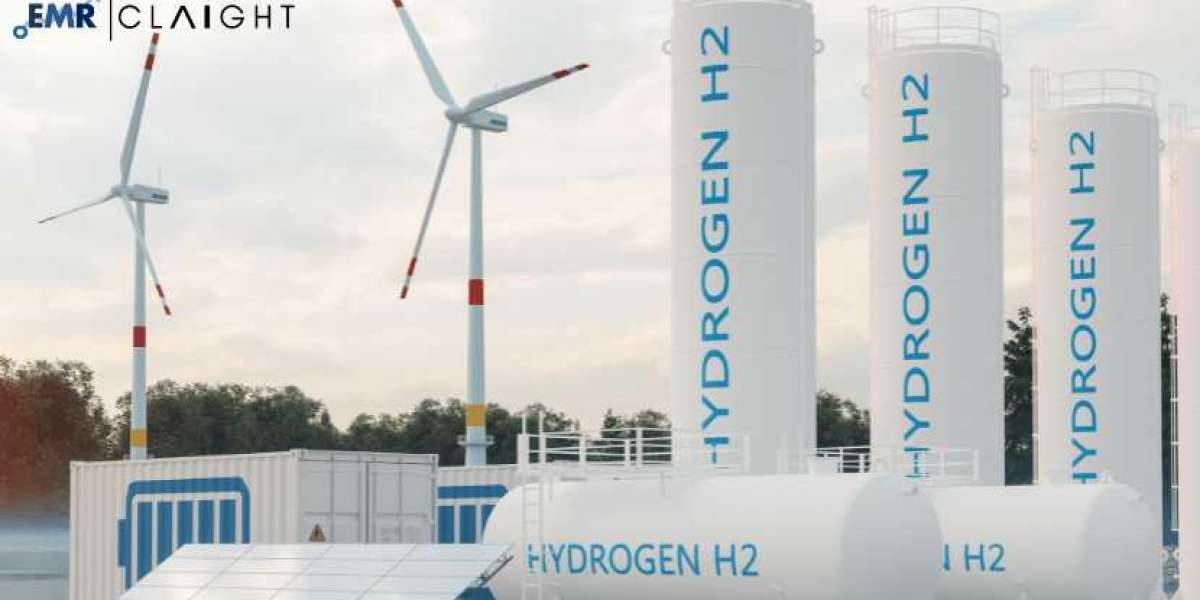Hydrogen Generation Market Outlook
The global hydrogen generation market reached a value of USD 165.77 billion in 2023. The market is further expected to grow at a CAGR of 9.3% in the forecast period of 2024-2032 to reach a value of USD 367.28 billion by 2032. This growth is primarily driven by increasing demand for cleaner energy solutions and the rapid development of hydrogen as an alternative to conventional fossil fuels. The growing emphasis on reducing carbon emissions across industries is further boosting the hydrogen generation market, which plays a key role in enabling the shift toward sustainable energy sources.
Hydrogen, being a versatile energy carrier, finds applications in various industries, including transportation, power generation, and industrial processes. The rising adoption of fuel cell vehicles, combined with favorable government policies promoting clean energy initiatives, is expected to bolster the demand for hydrogen generation technologies globally.
Hydrogen Generation Market Share
The hydrogen generation market has witnessed substantial growth, marked by increasing investment in clean energy infrastructure and technological advancements. As industries transition to more eco-friendly energy solutions, hydrogen's role as a sustainable fuel source continues to expand. Hydrogen generation technologies are being widely adopted in sectors such as transportation, chemicals, and refining, further driving the market's growth trajectory.
Get a Free Sample Report with Table of Contents@https://www.expertmarketresearch.com/reports/hydrogen-generation-market/requestsample
A growing focus on renewable energy integration is also contributing to the expansion of the hydrogen generation market. Hydrogen's potential as a storage medium for excess renewable energy is making it a crucial component in achieving energy security and sustainability.
Key Market Segments
The hydrogen generation market is segmented based on technology, application, source, and region. The technology segment includes steam methane reforming (SMR), partial oxidation (POX), and electrolysis, with electrolysis gaining popularity due to its potential for green hydrogen production. Applications of hydrogen generation span various industries, including power generation, transportation, chemicals, and refining.
The market is also categorized based on the source of hydrogen generation, such as natural gas, coal, and renewables. With the global shift toward renewable energy, hydrogen produced via electrolysis using renewable energy sources is anticipated to witness substantial growth during the forecast period.
Hydrogen Generation Market Growth Analysis
The hydrogen generation market is undergoing a robust growth phase, driven by increasing demand for sustainable energy solutions and a growing emphasis on decarbonization. Hydrogen's potential to be produced from renewable sources, such as solar and wind energy, is fueling its adoption across various sectors. The transportation industry, in particular, is witnessing a surge in demand for hydrogen fuel cell vehicles, which offer zero-emission mobility solutions.
Moreover, hydrogen's ability to store energy for long durations positions it as a key player in balancing intermittent renewable energy sources like solar and wind. This growing integration of hydrogen in the renewable energy ecosystem is expected to significantly drive market growth in the coming years.
Hydrogen Generation Market Segmentation
The hydrogen generation market can be segmented into several categories based on technology, application, and source.
Technology:
- Steam Methane Reforming (SMR): Currently, SMR is the most widely used method for hydrogen production, primarily because of its cost-effectiveness. However, concerns about carbon emissions from SMR have led to increased interest in carbon capture technologies that can be integrated with SMR.
- Electrolysis: This method is gaining traction as it allows for the production of hydrogen from water using renewable energy sources, making it a cleaner alternative. Green hydrogen, produced via electrolysis using renewable energy, is expected to drive significant growth in the hydrogen generation market.
- Partial Oxidation (POX): This method involves the production of hydrogen by oxidizing hydrocarbons like natural gas or oil. POX is less common compared to SMR and electrolysis but is still used in certain industrial applications.
Application:
- Power Generation: Hydrogen is increasingly being used for power generation in combination with renewable energy sources. It provides a reliable energy storage solution, ensuring a steady energy supply even when renewable sources like wind or solar are not available.
- Transportation: The adoption of hydrogen fuel cell vehicles is on the rise, especially in regions like Europe, North America, and Asia-Pacific. Hydrogen fuel cells offer a clean and efficient alternative to traditional internal combustion engines, making them ideal for commercial vehicles, buses, and trucks.
- Industrial Processes: Hydrogen is widely used in industries such as chemicals and refining. It serves as a feedstock in ammonia production, methanol production, and in the refining of petroleum products.
Source:
- Natural Gas: The majority of hydrogen is currently produced from natural gas, specifically through SMR. While cost-effective, this method generates significant CO2 emissions, prompting the development of greener alternatives.
- Renewables: Green hydrogen, produced through electrolysis powered by renewable energy sources, is emerging as a key growth area in the hydrogen generation market. As governments globally increase their focus on clean energy, investments in renewable hydrogen are expected to surge.
- Coal: Though coal gasification is a method of hydrogen production, it is increasingly being phased out due to its high carbon footprint and environmental concerns.
Hydrogen Generation Market Trends and Opportunities
The hydrogen generation market is experiencing several key trends and opportunities that are propelling its growth:
Shift Toward Green Hydrogen: As global efforts to reduce carbon emissions intensify, there is growing interest in green hydrogen, which is produced via electrolysis using renewable energy sources. Governments and organizations worldwide are investing in the development of green hydrogen infrastructure, offering significant growth opportunities for market players.
Rising Adoption in Transportation: The transportation sector is increasingly adopting hydrogen fuel cell technologies as a clean alternative to conventional fuels. The development of hydrogen refueling infrastructure, particularly in Europe, Asia-Pacific, and North America, is expected to drive the demand for hydrogen generation technologies.
Energy Storage Solutions: Hydrogen's ability to store large amounts of energy for extended periods makes it a crucial component in addressing the challenges of renewable energy intermittency. This growing demand for energy storage solutions is creating opportunities for hydrogen generation technologies.
Technological Advancements: Innovations in hydrogen production technologies, such as the development of more efficient electrolysis systems and advancements in carbon capture technologies for SMR, are opening new avenues for market growth. These advancements are helping to lower production costs and increase the efficiency of hydrogen generation processes.
Government Support and Policies: Many governments worldwide are implementing favorable policies and financial incentives to promote the adoption of hydrogen as part of their clean energy strategies. For instance, the European Union’s Green Deal and the U.S. Infrastructure Investment and Jobs Act both include provisions for hydrogen infrastructure development, which is expected to boost market growth.
Hydrogen Generation Market Competitive Landscape
The hydrogen generation market is highly competitive, with several key players continuously striving to enhance their market position through innovation and strategic initiatives. Companies are focusing on expanding their hydrogen production capacities, exploring new applications, and forming partnerships to strengthen their market presence.
Leading players in the hydrogen generation market include:
- Air Liquide S.A.: One of the leading providers of hydrogen solutions, Air Liquide is actively investing in hydrogen production and distribution infrastructure, particularly focusing on green hydrogen projects.
- Linde Plc: A global leader in industrial gases, Linde is involved in multiple hydrogen generation projects, including the development of large-scale electrolyzers for green hydrogen production.
- Nel ASA: A prominent player in the electrolyzer market, Nel ASA is focused on developing efficient electrolysis technologies for green hydrogen production.
- Plug Power Inc.: Known for its fuel cell solutions, Plug Power is expanding its hydrogen generation capabilities and is working on several green hydrogen projects across the globe.
Other key market participants include Siemens Energy, Engie, and Cummins Inc. These companies are investing heavily in hydrogen generation technologies and collaborating with governments and industries to support the global transition to clean energy,
Read More Reports:
https://www.expertmarketresearch.com/reports/semiconductor-market
https://www.expertmarketresearch.com/reports/gypsum-board-market
https://www.expertmarketresearch.com/reports/gypsum-board-market/market-size
Media Contact:
Company Name: Claight Corporation
Contact Person: Eren smith, Corporate Sales Specialist – U.S.A.
Email: [email protected]
Toll Free Number: +1-415-325-5166 | +44-702-402-5790
Address: 30 North Gould Street, Sheridan, WY 82801, USA
Website: https://www.expertmarketresearch.com
Aus. Site: https://www.expertmarketresearch.com.au



